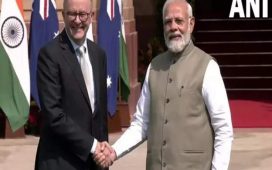Eighteen years later, India is hosting a second coming-of-age party this week at the World Economic Forum in the Swiss Alpine town, though in vastly changed circumstances.For one thing, the most-populous nation no longer needs qualifiers like “the world’s fastest-growing free-market democracy” to highlight its exceptionalism — at 7.3%, it’s expanding quicker than any other major economy. Nor does New Delhi need to apologize for frequent political change. Narendra Modi has been prime minister for the past decade, and will most likely win a third five-year term. For a West that has fallen out of love with China under President Xi Jinping, India is quite naturally the next big thing.But there is a fly in the ointment. The structure of the Indian economy is also turning Chinese, or at least exhibiting characteristics associated with the People’s Republic. The world’s second-largest economy has relied too much on investment, and suppressed consumption. Continuing with the status quo may worsen its debt overhang. But shifting gears won’t be easy either.
India has always been different. While China’s private final consumption expenditure has struggled to get past 40% of output in the past two decades, Indian households’ outlay on goods and services has routinely accounted for 55% to 60% of GDP. Underinvestment may have held back growth, but a higher share of domestic spending has helped the economy avoid Chinese-style financial excesses and debt addiction.
However, something has snapped. Private purchases of goods and services in inflation-adjusted terms is crawling at just 4.4%, its second-slowest pace in more than two decades and much more sluggish than the broader economy. Now that the post-pandemic boom in spending has petered out, families that aren’t at the top of the income pyramid are struggling. They’re becoming more dependent on debt, with unsecured personal loans surging 30% a year. Yet, two-wheeler sales, a barometer of mass consumption, is way below its pre-pandemic peak.
This may not be a blip. From the gleaming new $2 billion bridge in Mumbai that Modi inaugurated last week to a new international airport in a northern town where he will consecrate a Hindu temple on Jan. 22 to buttress his reelection bid, the emphasis is on boosting the capital stock.
Expect this focus to become even sharper in Modi’s third term. Since its 2001 entry into the World Trade Organization, China has regularly invested more than 40% of output. India’s needle is stuck at 30%, six percentage points lower than the peak it hit before the 2008 Global Financial Crisis. And this is despite an all-out push to shore up physical capital with corporate tax cuts, $24 billion in fiscal incentives for domestic manufacturing, and a pickup in public spending on infrastructure.
 Bloomberg
BloombergThe question is, will this top-down effort — spearheaded by a small national team of influential billionaires — trickle down fast and deep enough to absorb the surplus labor that got stuck in villages during the Covid-19 outbreak? In Mumbai-based Axis Capital’s calculations, India’s GDP is 1.2 years behind its pre-pandemic path. For an economy that adds 12 million potential jobseekers a year, that automatically shuts out 1.2 times 12 — or about 14 million to 15 million workers — from the employment market.
That’s a big hole, not just in the wages earned by 21% of the workforce, but also in the operating surpluses of the 39% who run their own business, and in the incomes of another 18% employed by them. Labor in India doesn’t yet have sufficient pricing power to beat inflation, says the Axis report. A new investment cycle might just mean consumption growth lagging GDP expansion on a more sustained basis, though not everyone will be affected. The top 20% of income earners will witness faster growth than the bottom 50%. “Labor markets are unlikely to be much better for the middle-30% as well,” the analysts say.
The talk in Mumbai’s financial circles is about a cheery prediction by Goldman Sachs Group Inc. that by 2027 100 million Indians will enjoy incomes of at least $10,000 a year, five times the national average. That this so-called affluent class was only 24-million-strong when Modi came to power shows why he enjoys robust support among the neo-rich, especially asset owners. Still, luxury spending and a buoyant stock market can’t be the end goals of policymaking. Growth that doesn’t raise the living standards of 80% of the workers is perhaps the wrong template.
There may be a better one, and it also happens to be Chinese. Ashwini Deshpande, an economist at Ashoka University in New Delhi, has argued in favor of China’s Township and Village Enterprise model. Before giving way in the 1990s to a more capital-intensive growth engine concentrated in coastal parts of southern China, TVEs had already raised rural China’s share in industrial production to 30%, a 10-fold jump from 1971. Something similar may help draw out India’s excess farm labor, especially women who can’t travel long distances to look for work in cities — the supporting social and economic infrastructure simply doesn’t exist. Still, the odds are that policymakers will continue to prioritize high-tech manufacturing. But who’ll be the buyers of Indian-made electric cars if local purchasing power is limited?
In the 2000s, it was the West that overlooked the interests of its workers to allow the rise of China’s factory labor. Rich nations are unlikely to repeat that politically costly experiment with another large, labor-surplus country, especially as the world economy’s potential growth rate is seen slowing to a three-decade low. India’s resilience will come from broad-basing domestic spending with better-quality jobs and higher purchasing power. For a country of 1.4 billion people to be driven by just 100 million consumers will store up trouble.
While China is knocking on the doors of the rich-nations’ club, India is still a lower-middle-income economy, with many more years of wooing at Davos ahead of it. If New Delhi gets the strategy right, the allurement will follow.







